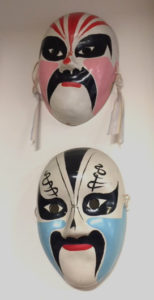 BR sends me two Japanese masks that she picked up outside of a theater in Kyoto in the 1960’s. She wonders where they fit in with the history of traditional Japanese Art Forms. She knows these two masks are not valuable because she remembers what she paid. She thinks they are Kabuki masks, and she is right. Masks in Japan fit into a series of traditional arts, and when I say traditional, I mean a collection of art forms practiced for thousands of years. This artistic longevity is virtually unknown in American life.
BR sends me two Japanese masks that she picked up outside of a theater in Kyoto in the 1960’s. She wonders where they fit in with the history of traditional Japanese Art Forms. She knows these two masks are not valuable because she remembers what she paid. She thinks they are Kabuki masks, and she is right. Masks in Japan fit into a series of traditional arts, and when I say traditional, I mean a collection of art forms practiced for thousands of years. This artistic longevity is virtually unknown in American life.
Japanese traditional art forms didn’t become known in the Western World before the mid-19th century. Commodore Matthew C. Perry of the US Navy “opened Japan to the West” in 1854, followed by Townsend Harris (1855), the first US Consul-General to Japan. The list of Europeans, who actually knew Japan well, previous to the mid-19th century, is slim, beginning only 479 years ago, when two Portuguese traders landed on Tanegashima in 1543. These two traders were the first Europeans to set foot in Japan.
Japanese culture has a long rich tradition, only known to Europeans for the last 500 years, and then hidden until 1854. When I write about the traditional art forms, I’m standing apart from all those years of cultural enrichment. That kind of artistic legacy isn’t an American tradition.
Japanese art forms are graceful, rich, and seemingly uncomplicated, but don’t be fooled, stately, and beautiful:
- One thousand years ago, calligraphy was an established art form as both art and poetry.
- Yes, you think you have a good florist, but think of Ikebana, a traditional form of studying balance and form. Here the branch and the stem are just as beautiful, when treated in concert in an arrangement, as the bud or flower.
- How appropriate that woodblock prints, of the 17th through the 19th century, are called Ukiyo-e, literally “images of the floating world.” The world floats on distractions, and these images pictured courtesans and theater.
- Lacquerware (Shikki) is the finest finish with which to coat and preserve wood, and this art form is used for both dining, and dressing, tables.
- About 1,000 years ago, Heian Noblemen served tea to others of the nobility, and the Tea Ceremony was born. Think about the formality of slowing down to drink tea in company the next time you visit Starbucks.
- The game of Kodo was a nobleman’s game in which a rare stick of incense was burned, and guests guessed at the ingredients.
We come to the relevance of BR’s masks, the art form of Traditional Japanese Dance, of which there are two types: Kabuki and Noh. In Noh, the masks are the main characters of a musical, a dramatic form that has been around for over 600 years, the oldest Japanese performance art. Spectators recognize mask types, because the plays are based on well-known myths. Masks are also worn in Shinto dances at shrines or festival, and are for sale there.
The characters portrayed are the Oni, a red-faced demon. Parents wear Oni to remind children to cast away the demon – kids throw beans at the mask! Tengu are the bird-men who frighten away bad spirits, recognizable by their long red noses. The Shinto revere the fox as a magical shape-shifter, and they have their own mask. The Clown is Hyottoko, with a rounded face, and a round mouth held to one side. A whole series of masks are devoted to the comic interlude, the intermission in the Noh theatre. Bringing good luck is the fat lady mask called Okame, doing a funny dance. Since only men dance Noh, the role of the beautiful woman is portrayed in the Onnamen mask. Recognize her by her oval face. All these masks are danced on the stage in formal movements.
Like many cultures (similarly America masks at Halloween), masking is part of a ritual, and we wear masks to join into an event, a myth we traditionally recognize. (Think of all the boys and girls as superheroes.) BR’s masks, because of their strong red and black accents belong to the Kabuki theatre, and can be purchased for $25 each.
Masks represent the contradictory identities that each human holds in faces, minds, and bodies. I notice that the bird-man Tengu is part of your lexicon even if you didn’t know it. He’s on your phone in emoji form 👺, containing both good and evil, bird and man, good luck, and a bad (phone) spirit.
Pingback: Gender Bending Wedding kimono - Elizabeth Appraisals
Hi, I bought 3 antique Japanese Ukiyo-E Kabuki woodblock prints on deceased estate auction, and would like to know if they’re worth any?
Thank you
Dirk
If you want to submit object for a possible article please email photos to elizabethappraisals@gmail.com